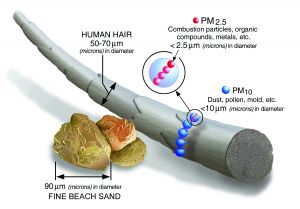Template:Main Page News: Difference between revisions
mNo edit summary |
mNo edit summary |
||
| (4 intermediate revisions by the same user not shown) | |||
| Line 1: | Line 1: | ||
{| width=800px| | {| width=800px| | ||
|-bgcolor="CEDFF2" | |-bgcolor="CEDFF2" | ||
| <span style="font-size:150%">'''News - | | <span style="font-size:150%">'''News - Abnormal Development - Air Pollution'''</span> | ||
|-bgcolor="F5FAFF" | |-bgcolor="F5FAFF" | ||
| valign=top| [[File: | | valign=top|[[File:Particulate matter.jpg|thumb|link=Abnormal Development - Air Pollution|Particulate matter comparative size]] | ||
'''Prenatal and early life exposures to ambient {{air pollution}} and development'''{{#pmid:30979514|PMID30979514}} | |||
<br>"Residential proximity to major roadways, and prenatal exposures to particulate matter <2.5 μm (PM2.5) and ozone (O3) are linked to poor fetal outcomes but their relationship with childhood development is unclear. We investigated whether proximity to major roadways, or prenatal and early-life exposures to PM2.5 and O3 increase the risk of early developmental delays. 4089 singletons and 1016 twins born between 2008 and 2010. Proximity to major roadway was calculated using road network data from the NY Department of Transportation. Concentrations of PM2.5 and O3 estimated by the Environmental Protection Agency Downscaler models were spatiotemporally linked to each child's prenatal and early-life addresses incorporating residential history, and locations of maternal work and day-care. In this prospective cohort study, proximity to major roadway and prenatal/early-life exposures to PM2.5 and O3 were associated with developmental delays. While awaiting larger studies with personal {{air pollution}} assessment, efforts to minimize {{air pollution}} exposures during critical developmental windows may be warranted." | |||
See also {{#pmid:30826615|PMID30826615}} | |||
{{ | <references/> | ||
:'''Links:''' {{air pollution}} | {{Neural postnatal}} | {{Neural examination}} | {{epigenetics}} | |||
{| class="wikitable mw-collapsible mw-collapsed" | {| class="wikitable mw-collapsible mw-collapsed" | ||
! Older News Articles | ! Older News Articles | ||
|- | |- | ||
| [[Template_talk:Main_Page_News|'''Older News Articles''']] - [[Template_talk:Main_Page_News#February|Rare Sesquizygotic Twinning]] | [[Template_talk:Main_Page_News#October|Spinal Muscular Atrophy Screening]] | [[Template_talk:Main_Page_News#February|Australian 2018 Pregnancy Care Guidelines]] | [[Template_talk:Main_Page_News#July|CRISPR]] | [[Template_talk:Main_Page_News#June|Ronan O’Rahilly]] | [[Template_talk:Main_Page_News#February|Gestational Diabetes]] | [[Template_talk:Main_Page_News#September|Kyoto eBook]] | [[Template_talk:Main_Page_News#August|Dolly's sisters live on!]] | [[Template_talk:Main_Page_News#June|Thalidomide in Zebrafish]] | [[Template_talk:Main_Page_News#March|Human pancreas stem cells]] | [[Template_talk:Main_Page_News#January|Oral contraceptive no risk of major birth defects]] | [[Template_talk:Main_Page_News#September|Maternal Malaria Neurovascular Development Effects]] | [[Template_talk:Main_Page_News#June|Oocyte/Spermatozoa fate decision]] [[Template_talk:Main_Page_News#April|Rubella eliminated in the Americas]] | [[Template_talk:Main_Page_News#February|Three-person embryos]] | | [[Template_talk:Main_Page_News|'''Older News Articles''']] - [[Template_talk:Main_Page_News#February|Rare Sesquizygotic Twinning]] | [[Template_talk:Main_Page_News#June|Australia's mothers and babies 2017]] | [[Template_talk:Main_Page_News#October|Spinal Muscular Atrophy Screening]] | [[Template_talk:Main_Page_News#February|Australian 2018 Pregnancy Care Guidelines]] | [[Template_talk:Main_Page_News#July|CRISPR]] | [[Template_talk:Main_Page_News#June|Ronan O’Rahilly]] | [[Template_talk:Main_Page_News#February|Gestational Diabetes]] | [[Template_talk:Main_Page_News#September|Kyoto eBook]] | [[Template_talk:Main_Page_News#August|Dolly's sisters live on!]] | [[Template_talk:Main_Page_News#June|Thalidomide in Zebrafish]] | [[Template_talk:Main_Page_News#March|Human pancreas stem cells]] | [[Template_talk:Main_Page_News#January|Oral contraceptive no risk of major birth defects]] | [[Template_talk:Main_Page_News#September|Maternal Malaria Neurovascular Development Effects]] | [[Template_talk:Main_Page_News#June|Oocyte/Spermatozoa fate decision]] [[Template_talk:Main_Page_News#April|Rubella eliminated in the Americas]] | [[Template_talk:Main_Page_News#February|Three-person embryos]] | ||
|} | |} | ||
|} | |} | ||
Revision as of 10:53, 4 December 2019
| News - Abnormal Development - Air Pollution |
|
Prenatal and early life exposures to ambient air pollution and development[1]
See also [2]
|
